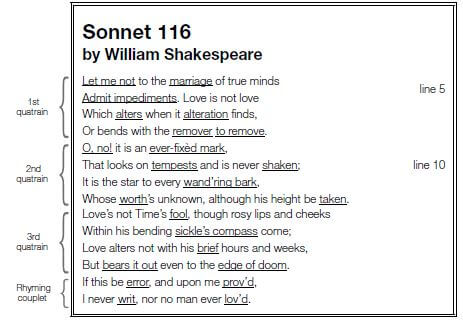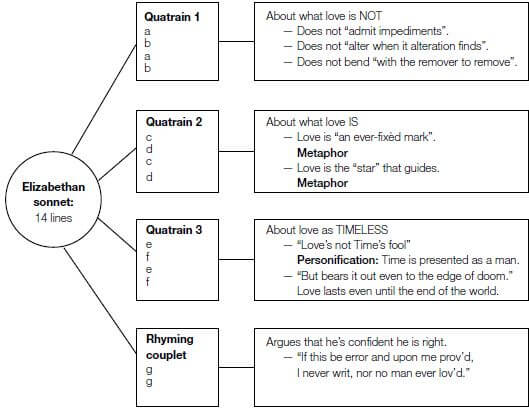SONNET 116 BY WILLIAM SHAKESPEARE GRADE 12 NOTES - LITERATURE POETRY STUDY GUIDE
Share via Whatsapp Join our WhatsApp Group Join our Telegram GroupSonnet 116 by William Shakespeare
Sonnet 116: Let me not to the marriage of true minds was written by William Shakespeare (1564-1616). He lived in England at the time of Queen Elizabeth I and he is one of the most famous English writers. He wrote many plays and over 150 poems. Like this one, most of the poems are sonnets which deal with themes of love, time, and their effect on people and relationships.
1. Themes
The main theme of Sonnet 116 is love. Shakespeare is saying that nothing can stop true love and that it never changes, no matter what happens in life. True love can survive even during life’s problems and can guide you through difficult times. Not even time can destroy true love, which lasts forever.
The poet is so sure of what true love is that he says that, if he is wrong, then he has never written anything, including this poem! This is how he concludes his argument that true love is constant and everlasting.
Note: This poem is written in Elizabethan English. The glossary after the poem gives the deunitiono of Elizabethan words.

Definitions of words from the poem: | ||
Line 1: | let me not | don’t allow me to |
marriage | union, unity, bond | |
Line 2: | admit impediments | allow obstacles, flaws or anything else to get in the way |
Line 3: | alters | changes |
alteration | a change | |
Line 4: | remover | person taking (love) away; |
to remove | to take away | |
Line 5: | ever-fixèd mark | permanent, unchanging marker |
Line 6: | tempests | storms, challenges |
shaken | moved | |
Line 7: | wand’ring bark | ship lost at sea |
Line 8: | worth | value |
taken | measured | |
Line 9: | fool | servant |
Line 10: | sickle | a tool used to cut grass; |
compass | range; direction | |
Line 11: | brief | short |
Line 12: | bears it out | makes it last |
edge of doom | end of the world; end of time; death | |
Line 13: | error | mistake |
Line 14: | writ | wrote |
2. Type and form
Sonnet 116 is an Elizabethan sonnet. It has 14 lines in one verse that is made up of:
- Three quatrains of four lines each; and
- A rhyming couplet of two lines at the end of the poem.
The rhyming scheme for Sonnet 116 is abab cdcd efef gg
Rhyme: Words at the end of the lines which have the same sound such as "minds" and "finds".
3. Analysis
First quatrain (lines 1 – 4) Let me not to the marriage of true minds |
In the first quatrain, the poet suggests what love is not. Nothing should get in the way (“impediments”) of people who are united (perhaps by love or marriage) and have the same values (“true minds”). People who have true minds share the same beliefs, values and ideas. They may be close friends or family members, not only lovers or people who are married in an official way.
Note: Marriage can also mean a closeness or union between two people who love each other.
He celebrates this kind of love and explains that true love does not change (“alters”) when circumstances change (“it alteration finds”). True love stays constant (steady or even) and stable and it does not weaken (“bend”) when there are difficult times, or the loved one does not seem to love any more.
The poet emphasises that love which changes or weakens is not true love by repeating “alter” and “alteration”; and “remover” and “remove” - these words suggest things that take love away or change love.
Note: Notice how "work" amd "bark" rhyme as do "shaken" and "taken".
Second quatrain (lines 5 – 8) O, no! it is an ever-fixèd mark |
In this quatrain, the poet suggest what love is. The poet explains that he thinks the love of true minds is stable and permanent. His exclamation, “O, no!” indicates how strongly the poet rejects the idea that anything can change true love. The poet then uses metaphors based on ships and sailing to tell us what love really is.
In the first metaphor the poet says that true love is an “ever-fixèd mark”, perhaps like a lighthouse. It stays shining and constant as a guide even during the worst storms (“tempests”). This metaphor tells us that true love is faithful and steady and will help you to manage even the worst of life’s problems.
In the second metaphor, Shakespeare says that true love is the “star” that guides a ship that has gone off course or got lost (“wand’ring bark”). This star refers to the North Star, which was used by a ship’s captain to steer a ship in the right direction as it is a constant star, always in the same place in the sky. He is saying that true love is constant and never changes its nature. It can be trusted to guide you through life, like the North Star guides a “wand’ring bark” or a ship lost at sea.
Shakespeare also says that, although the position of a star can be measured, we cannot know the worth or value of the star. In the same way, the value of true love is something which cannot be measured, so its worth is “unknown” (line 8), although it can give us direction and meaning in life.
Did you know: In Shakespear's day, sailing ships were made of wood. The captain steered the ship by measuring the position of the stars to guide the ship across the sea.
Third quatrain (lines 9 – 12) Love’s not Time’s fool, though rosy lips and cheeks |
In the third quatrain, the poet tells us that such love is timeless – it cannot be measured and lasts to the end of the world.
The passing of time has no effect on true love. The use of a capital letter in “Time” tells us that this is personification, that Time is a person. Shakespeare is writing about time as if it is a man, so he writes “his” not “its”.
However, the speaker in the poem says that love is not the “fool” of Time. He says that love is not a servant that has to obey Time’s rules and so, although Time destroys youth and beauty (cuts down “rosy lips and cheeks” with his “sickle”), love does not change. The poet says that love will last forever, even until the end of the world (“the edge of doom”).
Did you know: Father Time is also called the Grim Reaper or Death. He carries a sickle to harvest people, as a farm worker cuts grass with a sickle. He destroys our youth and beauty so that we get old and wrinkled.
Rhyming couplet (lines 13 – 14) If this be error and upon me prov’d, |
After telling us that love does not change (first quatrain), that love gives us guidance (second quatrain) and finally that love never ends (third quatrain), the poet ends the poem with a little joke. He says that if anyone can prove that his views of love are wrong then it would mean that he didn’t write anything and that no one has ever loved anyone.
This is a clever argument to end the poem with because we all know that Shakespeare has written – we are studying one of his poems right now – and of course people have loved before, and so what he says about love must be correct.
4. Tone and mood
The tone of the poem is generally confident. Shakespeare believes so strongly in love that he does not say love is “like” anything (a simile). Instead, he uses metaphors to say that love IS that thing: love IS a “star” and love IS an “ever-fixèd mark”.
In the third quatrain, Shakespeare’s tone is scornful of Time’s “brief hours and weeks” because true love is not affected by time. Time passes and we grow old and die but love does not die.
The tone of the rhyming couplet is persuasive. The poet or speaker wants to persuade the reader to agree with his views about true love.
The mood of a poem is how it makes the reader feel. How does this poem make you feel? For example, happy, sad, angry, or indifferent?
Note: Scournful is an expression of digust towards someone or something that is seen as unworthy.
Also have you noticed that there are no similies in this poem, only metaphors?
Summary
Sonnet 116 : Let me not to the marriage of true minds by William Shakespeare
- Theme
- Love is constant and everlasting.

- Love is constant and everlasting.
- Type and form
- Tone and mood
- Tone: Confident, scornful, persuasive
- Mood: How does this poem make you feel? Happy, sad, angry or indifferent? Always give reasons for your answer.
Activity 1
Refer to the poem on page 2 and answer the questions below.
- Complete the following sentence by using the words provided in the list below.
This is a typical (1.1) ... sonnet because of the three (1.2) ... and the (1.3) ... that rhymes. (3)Petrarchan; sestet; Elizabethan; Couplet; quatrains; octave - Quote a word in the first line which has connotations of love and unity. (1)
- Refer to the following words in line 1 (“... the marriage of true minds”).
To what do these words refer? (2) - Refer to lines 2-4 (“Love is not love ... remover to remove”).
Using your own words, explain the meaning of these lines. (2) - Choose the correct answer to complete the following In line 5, the words “O, no ...” show that the speaker is ...
- uncertain.
- arrogant.
- doubtful.
- convinced. (1)
- Refer to line 7 (“It is the star to every wand’ring bark”).
Give the literal meaning of the underlined words. (1) - Is the following statement TRUE or FALSE? Quote THREE consecutive words to support your answer.
It is impossible to measure the value of love. (2) - Refer to the following words in line 9 (“Love’s not Time’s fool”). Identify the figure of speech used (1)
- Refer to lines 13 and 14 (“If this be ... man ever loved”).
How does the poet use the last two lines to make his argument on true love convincing? (2) - Do you agree with the speaker’s view of love? Explain your (2) [17]
Note:
- Connotations - words with meanings linked to a key word. For example, the connotations of "morning" are fresh,new,early.
- Consecutive words - words that directly follow after one another.
Answers to Activity 1
|
Hint ; In question 7, one mark will be given if the first part of the answer (true) is correct. To get 2 marks, give the correct answer and quote the correct three words.
Note: When a question asks for your own view or opinion, you must say if you agree or not and then give a reason for your viewpoint to get 2 marks.
